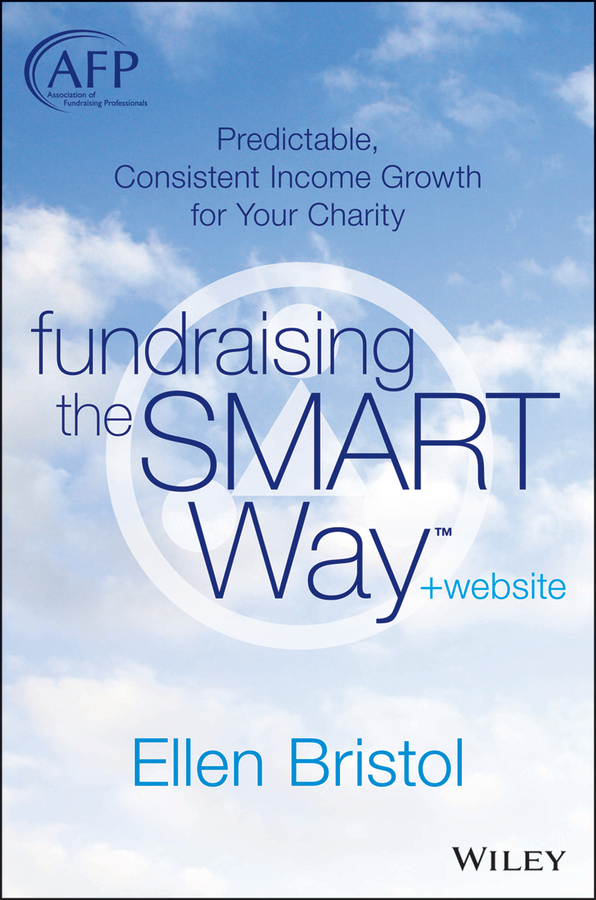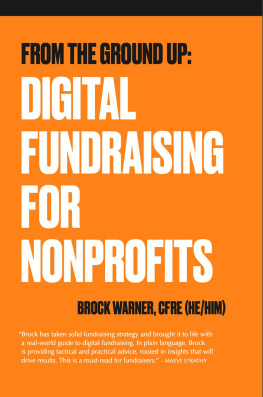
Series Page
The AFP Fund Development Series is intended to provide fund development professionals and volunteers, including board members (and others interested in the nonprofit sector), with top-quality publications that help advance philanthropy as voluntary action for the public good. Our goal is to provide practical, timely guidance and information on fundraising, charitable giving, and related subjects. The Association of Fundraising Professionals (AFP) and Wiley each bring to this innovative collaboration unique and important resources that result in a whole greater than the sum of its parts. For information on other books in the series, please visit:

http://www.afpnet.org
Cover image: iStockphoto/grafikeray
Cover design: Wiley
Copyright 2014 by Ellen Bristol. All rights reserved.
Published by John Wiley & Sons, Inc., Hoboken, New Jersey.
Published simultaneously in Canada.
No part of this publication may be reproduced, stored in a retrieval system, or transmitted in any form or by any means, electronic, mechanical, photocopying, recording, scanning, or otherwise, except as permitted under Section 107 or 108 of the 1976 United States Copyright Act, without either the prior written permission of the Publisher, or authorization through payment of the appropriate per-copy fee to the Copyright Clearance Center, Inc., 222 Rosewood Drive, Danvers, MA 01923, (978) 750-8400, fax (978) 646-8600, or on the Web at www.copyright.com. Requests to the Publisher for permission should be addressed to the Permissions Department, John Wiley & Sons, Inc., 111 River Street, Hoboken, NJ 07030, (201) 748-6011, fax (201) 748-6008, or online at http://www.wiley.com/go/permissions.
Limit of Liability/Disclaimer of Warranty: While the publisher and author have used their best efforts in preparing this book, they make no representations or warranties with respect to the accuracy or completeness of the contents of this book and specifically disclaim any implied warranties of merchantability or fitness for a particular purpose. No warranty may be created or extended by sales representatives or written sales materials. The advice and strategies contained herein may not be suitable for your situation. You should consult with a professional where appropriate. Neither the publisher nor author shall be liable for any loss of profit or any other commercial damages, including but not limited to special, incidental, consequential, or other damages.
Selling the SMART Way is a registered trademark of Bristol Strategy Group. Fundraising the SMART Way, a variant of Selling the SMART Way, is a common-law trademark of the same company.
For general information on our other products and services or for technical support, please contact our Customer Care Department within the United States at (800) 762-2974, outside the United States at (317) 572-3993 or fax (317) 572-4002.
Wiley publishes in a variety of print and electronic formats and by print-on-demand. Some material included with standard print versions of this book may not be included in e-books or in print-on-demand. If this book refers to media such as a CD or DVD that is not included in the version you purchased, you may download this material at http://booksupport.wiley.com. For more information about Wiley products, visit www.wiley.com.
ISBN 978-1-118-64018-0 (Hardcover)
ISBN 978-1-118-64033-3 (ePDF)
ISBN 978-1-118-64024-1 (ePub)
Dedication
This book is dedicated to Riley, Cade, and Aaron, the next, next generation.
Preface
In this book, I propose that we revisit the way fundraising is managed, not the way fundraising is done. There's a big difference. The way fundraising, or any other business function, is managed is what leads to high levels of productivity and sustainability. Managing a business function, including fundraising, means identifying the results desired from the fundraising effort, establishing performance targets and indicators, developing methods of doing it that are effective and in keeping with the organization's corporate values, and holding the do-ers accountable.
The way fundraising is done, on the other hand, describes the tactical activities of the fundraising staff, be they employees, contractors, or volunteers. Many fine fundraising professionals have raised their tactical skills to the level of art. We all know outstanding practitioners who specialize in grant-seeking, major gift work, capital campaigns, corporate relations, special events, and the list goes on. If there are, in fact, so many high performers out there in the fundraising discipline, how come fundraising remains the problem child of the nonprofit sector?
I contend that the nonprofit sector as a whole would enjoy more sustainable levels of income if the management of all that talent and art were to become more sophisticated, adopting some of the practices that support performance excellence in the for-profit sector. In fact, many nonprofit organizations, such as those in the fields of healthcare and healthcare research, practice extremely sophisticated management when it comes to service delivery and related programs. Many of them are required to do so by their certifying authorities. But as far as I can tell from the data and observation, it's the rare development shop that is managed strategically, with a stated intention to improve productivity.
By contrast, fundraising is largely tactical. If you're lucky enough to staff your development shop with senior superstars who already have relationships with the community's most willing philanthropists, it might not seem as if rigorous management methods are terribly important. But if your nonprofit is more typicalwith a budget of less than $10 millionit's more likely that you spend your share of sleepless nights worrying about how you're going to do better this year than you did last, afford to hire more experienced staff, upgrade your facilities, build capacity to serve more clients, or any of the other thousand-and-one issues that you'd like to handle, but aren't able to afford.
The only way to get out of this spiral, in my opinion, is to improve the management of the development shop. Sure, you might get an incremental bump by adopting some cool new tactics, or throwing another event. But such tricks aren't sustainable. If you rely only on tactics, it's pretty tough to figure out what's working or not working. In that case, all you can do is repeat the things you think might be working for you, or experiment with new tactical ideas. Your big event works? Throw another event. Nonprofit X uses online giving? Put up a PayPal page on your website. How well is it working? Well, it depends
The problem of how to improve fundraising results doesn't start with tactics, however. Its origins lie way upstream in the organization's mission, and in the way its leaders interpret that mission. When it comes to defining the organization's mission, I really like the way John Carver, developer of the Policy Governance model, breaks it down. He says that a well-defined mission shows the results the organization intends to achieve, describes the recipients of those results, and states what it should cost to achieve those results. To my way of thinking, working out what it should cost to achieve the organization's desired results is the springboard for fundraising success.
This doesn't mean that leadership has to do the work of fundraising. In spite of popular opinion, I think that having the board involved too intimately in fundraising activities can be counterproductive. Leadership should be involved in articulating desired outcomes, defining performance indicators and success targets, and thinking strategically about the agency's role in the community. Clarity about the whatWhat do we wish to accomplish?leads to clarity about the howHow do we know we're accomplishing it? That's a very big job indeed, one that's better suited to the high-level volunteers who serve on the governing board than the role of philanthropic solicitor,
Next page







